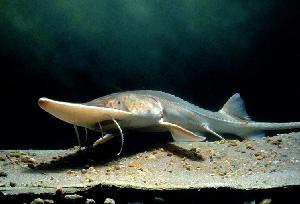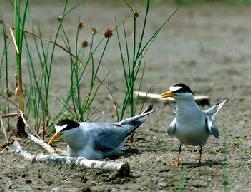Missouri River Management Proposals Offer
Conflicting Visions
By Cat Lazaroff, Environmental News Service
from http://ens-news.com/
WASHINGTON, DC, August 31, 2001 (ENS) - An
environmental review released today will help determine the
future course of Missouri River management - whether water flows
favor wildlife habitat and endangered species, or the barge
traffic that carries much of the Midwest's agricultural bounty.
The public will be offered an opportunity to comment on these
alternatives, and help decide the future of a river that has
been called the nation's most endangered.

The Corps dredges the Missouri River to accommodate barge
traffic, reducing suitable habitat for pallid sturgeon and other
species (Photo courtesy U.S. Army Corps of Engineers)
Two widely divergent visions for the river are buried within the
bureaucratic and technical language of the draft "Master
Water Control Manual" environmental impact statement for
the Army Corps of Engineers' six Missouri River dams. One vision
is for a river restored - supporting robust fish and wildlife
populations and driving the region's economy as a recreation and
tourism destination. The other is for the status quo - a river
shackled to protect a languishing barge industry and placate
unfounded fears of increased flooding.
"The question before us is, do we want a river we can be
proud of for the bicentennial of Lewis and Clark's voyage?"
said Rebecca Wodder, president of American Rivers, which
designated the river as the nation's Most Endangered River in
April 2001. "For more than ten years, a handful of special
interests have used every trick in the book to prevent the
public from having its chance to answer that."
The battle over competing visions for the river has raged for
more than a decade, but took on new urgency last November when
the U.S. Fish and Wildlife Service (USFWS) informed the Corps
that its dam operations were contributing to the decline of
three protected species. USFWS scientists called on the Corps to
release more water from the dams in the spring in some years,
and hold more water back each summer to improve river conditions
for the pallid sturgeon, the interior least tern and the piping
plover - and warned that the Army Corps would soon be in
violation of the Endangered Species Act if it failed to do so.
Changing flows as these scientists recommend would not just
prevent the extinction of the three species, but would improve
conditions for a tremendous variety of fish and wildlife species
that live in and along the river. By making the river a more
attractive destination for tourism and many types of outdoor
recreation, adjusting flows would expand economic activities
that already bring $90 million in economic benefits to the
region each year.

The threatened piping plover needs dry sand bars for
nesting. Current Missouri River management may flood that
habitat during nesting season (Photo courtesy Nebraska
Game and Parks Commission)
Agricultural and shipping interests that benefit from the status
quo along the river have thus far waged a successful fight to
prevent any adjustments in dam operations, challenging the
science behind the USFWS recommendations, predicting dire
consequences for floodplain farmers and commercial navigation,
and making unsubstantiated claims in the press about increased
flooding risk.
"Reforming dam operations on the Missouri River is as
much about people as it is about fish and wildlife," said
Wodder. "River species, recreation, floodplain farming,
hydropower, and all other uses of the Missouri River can coexist
if we choose to let them."
The draft environmental impact statement offers six
alternatives, but does not present a single preferred
alternative. Instead, the agency says it is seeking an open
discussion regarding all the options and their impacts rather
than focusing on a single plan.
The final environmental impact statement, scheduled for
release in May 2002, will contain a single preferred
alternative, based on science, public opinion, environmental
imperatives and other project purposes, such as navigation and
flood damage reduction, the Corps said.
"We have come to a very important point in the review
and update process for the Missouri River Master Manual,"
said Colonel David Fastabend, the Corps' northwestern division
engineer. "We feel it is important to present more than one
plan and receive comments from the people affected by the
proposed changes. The [Revised Draft Environmental Impact
Statement] includes analyses of the alternatives that allow
people to understand and compare the impacts of potential
changes."

Pallid sturgeon need strong spring flows to trigger
reproduction, and shallow water in the summer for young fish (Photo
by Ken Bouc, courtesy Nebraska Game and Parks Commission)
The Revised Draft Environmental Impact Statement (RDEIS)
analyzes the environmental effects of six alternative operating
plans for the Master Manual - the current water control plan, a
modified conservation plan, and four alternatives that add
various Gavins Point Dam releases to the modified conservation
plan, including a spring rise and low summer releases.
The document also offers a description of the economic,
social and environmental impacts on flood control, navigation,
fish and wildlife, hydropower, water supply, water quality,
recreation and irrigation.
There are features common to all the alternatives except the
current water control plan. The common features are:
Four alternatives add a range of modified releases from
Gavins Point Dam, including:

Four alternatives would involve altering water releases from
Gavins Point Dam in South Dakota (Photo courtesy U.S.
Army Corps of Engineers)
A "spring rise" from Gavins Point Dam of 15,000 cfs to
20,000 cfs for two weeks on average every three years to trigger
pallid sturgeon spawning. If implemented, the rise would begin
at 15,000 cfs, and the effects on sturgeon would be monitored
and evaluated. The rise would not be provided in years with high
downstream tributary flows like 2001 and would take downstream
flood threats into consideration.
Low annual releases from Gavins Point from mid-June to
mid-August to provide nesting habitat for least terns and piping
plovers. Releases would be reduced to the minimum navigation
service level of about 28,000 cfs to 21,000 cfs, followed by
monitoring and evaluation.
The Corps will accept public comments on the draft for six
months, until the end of February 2002. During that time,
workshops and hearings will be held from Helena, Montana, to New
Orleans, Louisiana, to explain the plans and take comments.
The Summary of the Revised Draft Environmental Impact
Statement, workshop schedule, library depositories and other
support material are available at http://www.nwd.usace.army.mil.
The complete document will be available by mid-September.

The endangered interior least tern needs exposed sand bars
to nest successfully (Photo courtesy USFWS)
Although relieved to reach this milestone after years of delay,
conservation groups pointed today to what they called
"troubling signs" that the Army Corps is stacking the
deck against changing dam operations:
- Despite several previous public commitments to announcing
its preferred alternative, the Corps declined to identify
the sole option that meets Endangered Species Act
requirements as its preferred alternative, or to provide any
options which exactly match the USFWS' recommendations.
- Hearings are not scheduled in Missouri River communities
such as Omaha, Nebraska, Garrison, North Dakota, and
Yankton, South Dakota, which depend heavily on recreational
use of the river.
- Hearings are scheduled in Memphis, Tennessee, and New
Orleans, Louisiana, home to substantial shipping interests,
which are not even on the Missouri River.
"It looks to me like this was a sweetheart deal between
the White House and Senator Kit Bond from Missouri," said
Senator Byron Dorgan, a North Dakota Democrat, in an August 17
statement on the draft plan.
American Rivers and other conservation organizations have
launched a new website, http://www.SaveTheMissouri.org,
to provide additional information on the Missouri River and
allow visitors to submit comments to the Corps via fax or
E-mail.
"Because the Corps is tilting the comment period in
favor of the status quo, it's particularly urgent for people who
want the Missouri River restored to speak up," Wodder said.
"Missouri River basin residents, hunters and anglers, and
anyone who cares about healthy rivers and fish and wildlife can
visit www.SaveTheMissouri.org and take action."
In accordance with Title 17 U.S.C. Section
107, any copyrighted work in this message
is distributed under fair use without
profit or payment for non-profit research
and educational purposes only. [Ref.
http://www.law.cornell.edu/uscode/17/107.shtml]